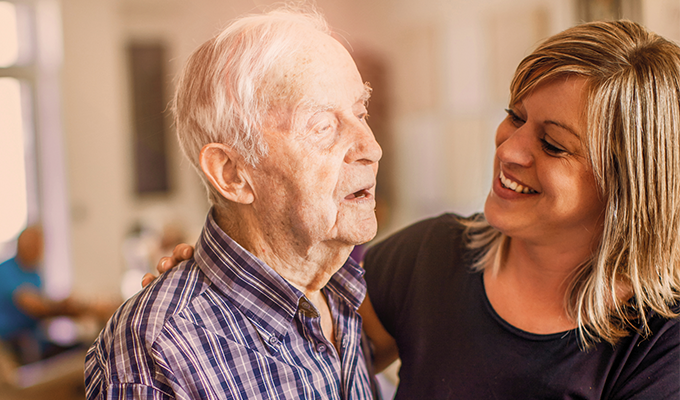Behaviour Support Plans mean a better supported person
Find out why – and how you can help

It is now a legal requirement for aged care providers to use Behaviour Support Plans (BSPs)
We know that the ways people in our care experience things can offer us insight into how they feel and what they need. Understanding this and being equipped with the right tools to support those who are signalling need for our support, is best practice care. The Behaviour Support Plan (BSP) is the power tool in this toolkit. A person with a good BSP is a Better Supported Person. That's why it is such good news that BSPs are now something we all need to have in place, for everyone we care for.
This website and behaviour support plan resources are here to help you understand behavioural support, what a good BSP looks like, provide a guide to creating a good behaviour support plan (BSP), and how to play your part in bringing BSPs to life.
Understanding the Behaviour Support Process
Step 1Identify

Step 1: Identify
- Identify there is a Changed Behaviour
- Identify any appropriate immediate response that might be needed to ensure safety
- Identify and implement any existing care plans in place
- Identify the changed behaviour to the wider care team through appropriate reporting
For many people, behaviour is a way of communicating. When we know a person well, we can recognise when their behaviour changes from what is ‘normal’ for them. We can tell when something is wrong or when the person might be trying to indicate that they have a need that has not been met. While every situation is unique to the person, there are some things to be aware of as signal behaviours. These include:
- Problems with eating or sleeping
- Verbal disruptions or physical aggression
- Resistance to care or help
- Wandering or intrusiveness
- Socially or sexually inappropriate behaviour
If the situation calls for it, the first response should be to focus on reducing any risk of harm and making sure everyone is safe. If there is an existing care plan, you should look to employ identified strategies and once things are under control, report on the situation.
Ask yourself:
- Is this person behaving in a way that indicates something is not right for them?
- Is this person acting in a way that is causing stress for them or others?
- If there is an existing care plan, are current strategies not effective?
Yes
If the answer to any or all of these questions is yes, move to Assess.
No
If the answers are no and you are still worried – talk to a senior team member about your concerns and review the situation.
Step 2Assess

Step 2: Assess
Once the situation is safe, the next step is to work out why the changed behaviour is happening, looking for possible causes for the behaviour needing support. This could include:
- Their physical health
- Their ability to reason and respond
- What sort of personality they have
- Whether there are sensory problems
- Their life history and what they care about
- Their mental health
- The environment they are in
- Their relationships with others, including family, other residents and staff
- Their communication skills and abilities
The level of detail that is needed in this assessment phase will depend on several things, including how easy it is to identify causes, how serious or frequent the behaviour is and the effectiveness of existing care strategies and interventions. Several resources and screening tools are available to assist your assessment. You can find more details about how to conduct your assessment in the Guide to Behaviour Support and on this website.
Ask yourself:
- Do I have a clear understanding about the reasons and contributing factors for the changed behaviour?
Yes
If the answer is yes, move to Plan.
No
If the answer is no – talk with the care team to get together more information about the resident, brainstorming possible causes or seeking external expert help - for example, from DSA consultants.
Step 3Plan

Step 3: Plan
As of September 2021, any resident that requires behaviour support by an aged care provider must have a Behaviour Support Plan (BSP) included in their care plan. Strategies you develop for a BSP will need to be tailored to the person and include consultation with them and their care partners.
The Behaviour Support Plan will need to include information about the person and their preferences. It should also consider how to change or manage things that may be causing the resident distress and/or how to work out ways to meet their needs.
Behaviour Support Plans must also identify what steps to take if things become unsafe. Some plans will be more straightforward. For example, if a person is behaving in particular ways because of treatable pain, strategies that focus on pain management and ongoing observation are likely to help resolve that person’s pain and their behaviour.
Other plans will be more complex and may need a range of strategies that can be trialled in different circumstances. As well as addressing underlying causes, these might include:
- Engagement strategies: Engaging the person in activities that are meaningful to them
- Communication strategies: Developing ways to connect to the person and their reality
- Environmental strategies: Removing causes and using spaces that can support them
Ask yourself:
- Do you feel confident the strategies in the plan will be effective for stopping or reducing the behaviours needing support?
Yes
If the answer is yes, move to Implement.
No
If the answer is no – work with the care team to review the plan and address any areas you see as unresolved. Get external support if you need it.
Step 4Implement

Step 4: Implement
Once the BSP is developed and care strategies are worked out, the next step is to implement those strategies.
It is important that effective communication systems are in place to make sure that all involved with the care of the person are aware of the changes to their care and are confident in delivering the support strategies in a consistent way. This will need each staff member to familiarise themselves with the BSP and it will need good consultation between members of the team.
Consistency in implementation of the BSP care strategies is essential to being able to evaluate whether those strategies are effective. All members of the care team will need to have a good understanding of the person, their likes, dislikes and history. This knowledge will allow staff to creatively problem solve and tweak particular strategies depending on the person and the circumstances.
When it comes to effective responses, nothing replaces knowledge of the person being cared for and careful judgment in the moment.
Ask yourself:
- Has the information in the plan been well-communicated to the wider team and are the care strategies being effectively and consistently implemented?
Yes
If the answer is yes, move to Evaluate.
No
If the answer is no – work with the care team to review the plan and address gaps in understanding or consistency. Get external support if you need it.
Step 5Evaluate

Step 5: Evaluate
It is important that the behaviour support plan is understood as a ‘live’ tool. This means it is meant to be regularly reviewed and revised as needed to make sure it continues to reflect the best approach to caring for the person as their care needs change.
The specific requirements for monitoring, evaluating and reviewing any BSP will depend on the type of plan that’s been developed, on the person being cared for and how they respond to the strategies in their BSP.
Monitoring must assess the effectiveness of any strategies, and careful records of monitoring and evaluating the success of the strategies must be kept. This ongoing evaluation is the responsibility of all staff. While there is no specific method, use of tools can include:
- The Behaviour Assessment Form (BAF)
- The Behaviour Frequency Chart (BFC)
- Regular consultation with staff, the person being cared for and their family
In addition to the ongoing monitoring and evaluating of specific strategies, the BSP must be ‘reviewed regularly’ or ‘as soon as practicable' after any change in the person’s circumstances.
Ask yourself:
- Do you feel confident that the evaluation process is making an effective contribution to the BSP?
Yes
If the answer is yes, Continue the process.
No
If the answer is no – work with the care team to review the evaluation process. Get external support if you need it.

Step 1: Identify
- Identify there is a Changed Behaviour
- Identify any appropriate immediate response that might be needed to ensure safety
- Identify and implement any existing care plans in place
- Identify the changed behaviour to the wider care team through appropriate reporting
For many people, behaviour is a way of communicating. When we know a person well, we can recognise when their behaviour changes from what is ‘normal’ for them. We can tell when something is wrong or when the person might be trying to indicate that they have a need that has not been met. While every situation is unique to the person, there are some things to be aware of as signal behaviours. These include:
- Problems with eating or sleeping
- Verbal disruptions or physical aggression
- Resistance to care or help
- Wandering or intrusiveness
- Socially or sexually inappropriate behaviour
If the situation calls for it, the first response should be to focus on reducing any risk of harm and making sure everyone is safe. If there is an existing care plan, you should look to employ identified strategies and once things are under control, report on the situation.
Ask yourself:
- Is this person behaving in a way that indicates something is not right for them?
- Is this person acting in a way that is causing stress for them or others?
- If there is an existing care plan, are current strategies not effective?
Yes
If the answer to any or all of these questions is yes, move to Assess.
No
If the answers are no and you are still worried – talk to a senior team member about your concerns and review the situation.

Step 2: Assess
Once the situation is safe, the next step is to work out why the changed behaviour is happening, looking for possible causes for the behaviour needing support. This could include:
- Their physical health
- Their ability to reason and respond
- What sort of personality they have
- Whether there are sensory problems
- Their life history and what they care about
- Their mental health
- The environment they are in
- Their relationships with others, including family, other residents and staff
- Their communication skills and abilities
The level of detail that is needed in this assessment phase will depend on several things, including how easy it is to identify causes, how serious or frequent the behaviour is and the effectiveness of existing care strategies and interventions. Several resources and screening tools are available to assist your assessment. You can find more details about how to conduct your assessment in the Guide to Behaviour Support and on this website.
Ask yourself:
- Do I have a clear understanding about the reasons and contributing factors for the changed behaviour?
Yes
If the answer is yes, move to Plan.
No
If the answer is no – talk with the care team to get together more information about the resident, brainstorming possible causes or seeking external expert help - for example, from DSA consultants.

Step 3: Plan
As of September 2021, any resident that requires behaviour support by an aged care provider must have a Behaviour Support Plan (BSP) included in their care plan. Strategies you develop for a BSP will need to be tailored to the person and include consultation with them and their care partners.
The Behaviour Support Plan will need to include information about the person and their preferences. It should also consider how to change or manage things that may be causing the resident distress and/or how to work out ways to meet their needs.
Behaviour Support Plans must also identify what steps to take if things become unsafe. Some plans will be more straightforward. For example, if a person is behaving in particular ways because of treatable pain, strategies that focus on pain management and ongoing observation are likely to help resolve that person’s pain and their behaviour.
Other plans will be more complex and may need a range of strategies that can be trialled in different circumstances. As well as addressing underlying causes, these might include:
- Engagement strategies: Engaging the person in activities that are meaningful to them
- Communication strategies: Developing ways to connect to the person and their reality
- Environmental strategies: Removing causes and using spaces that can support them
Ask yourself:
- Do you feel confident the strategies in the plan will be effective for stopping or reducing the behaviours needing support?
Yes
If the answer is yes, move to Implement.
No
If the answer is no – work with the care team to review the plan and address any areas you see as unresolved. Get external support if you need it.

Step 4: Implement
Once the BSP is developed and care strategies are worked out, the next step is to implement those strategies.
It is important that effective communication systems are in place to make sure that all involved with the care of the person are aware of the changes to their care and are confident in delivering the support strategies in a consistent way. This will need each staff member to familiarise themselves with the BSP and it will need good consultation between members of the team.
Consistency in implementation of the BSP care strategies is essential to being able to evaluate whether those strategies are effective. All members of the care team will need to have a good understanding of the person, their likes, dislikes and history. This knowledge will allow staff to creatively problem solve and tweak particular strategies depending on the person and the circumstances.
When it comes to effective responses, nothing replaces knowledge of the person being cared for and careful judgment in the moment.
Ask yourself:
- Has the information in the plan been well-communicated to the wider team and are the care strategies being effectively and consistently implemented?
Yes
If the answer is yes, move to Evaluate.
No
If the answer is no – work with the care team to review the plan and address gaps in understanding or consistency. Get external support if you need it.

Step 5: Evaluate
It is important that the behaviour support plan is understood as a ‘live’ tool. This means it is meant to be regularly reviewed and revised as needed to make sure it continues to reflect the best approach to caring for the person as their care needs change.
The specific requirements for monitoring, evaluating and reviewing any BSP will depend on the type of plan that’s been developed, on the person being cared for and how they respond to the strategies in their BSP.
Monitoring must assess the effectiveness of any strategies, and careful records of monitoring and evaluating the success of the strategies must be kept. This ongoing evaluation is the responsibility of all staff. While there is no specific method, use of tools can include:
- The Behaviour Assessment Form (BAF)
- The Behaviour Frequency Chart (BFC)
- Regular consultation with staff, the person being cared for and their family
In addition to the ongoing monitoring and evaluating of specific strategies, the BSP must be ‘reviewed regularly’ or ‘as soon as practicable' after any change in the person’s circumstances.
Ask yourself:
- Do you feel confident that the evaluation process is making an effective contribution to the BSP?
Yes
If the answer is yes, Continue the process.
No
If the answer is no – work with the care team to review the evaluation process. Get external support if you need it.
Get the free guide to creating a good behaviour support plan
These guidelines aim to support you to support the people you care for, well. To help you to understand the different things that can impact a person’s behaviour, and how to provide care and support in response to changes in behaviours.
Download the free guide
Your Download is One Step Away...
Please fill out the details below to download the BSP guide and/or all the BSP tools.
You only need to do this once. You can download immediately, and we'll email you a link to your download in case you want to get back to it later. Providing your details helps us understand your needs and improve the available tools.




 Call us now on
Call us now on